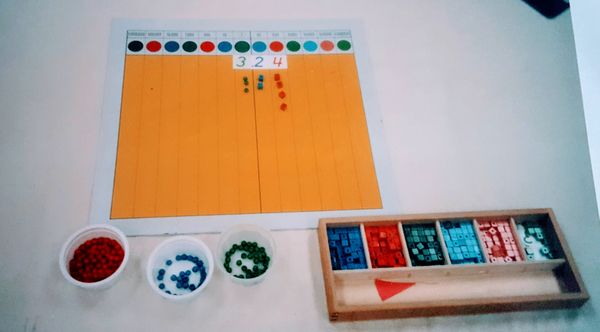Decimals Forming and Reading Decimal Numbers (Lesson 7)
Contents
Age
9-12
Materials
- Numeral cards from the bank game-to millions
- Decimal numerals cards- to millionths
- Decimal board
Preparation
Students should have had the Decimal Lessons 1-6 (We are moving from the concrete toward the abstract).
Presentation
This lesson is combining everything: spolen word, written symbol, quantity on the Decimal Board.
- 1. Form a whole number with two or three numeral cards, for instance, 324. Have the student(s) read the numeral and place the cards above the appropriate columns of the decimal board.
- 2. If the student is able to do that easily, form a number which includes decimals, e.g., 3.84. Invite the student to read it it; "Three AND eight tenths and four hundredths". Place the cards above the appropriate columns on the Decimal Board.
- 3. continue with several other examples of numerals combining whole numbers and decimals. Include a few numbers containing zeros, e.g., 45.067.
- 4. When the student(s) is/are able to do this comfortably, dictate a numeral to the student, again beginning with whole numbers. Have student(s) assemble the numeral from the correct cards and place them appropriately on the board. Continue doing this for numerals containing decimals: "three units, nine tenths, six hundredths."
In the process, challenge the students by dictating a number that omits one category, e.g., "three tens, two unitis, AND four hundredths." Also, ask the student(s) for the card four "ten tenths", and see if she/he realizes he/she umst give you the card for an equivalent amount = one unit.
- 5. When the student(s) can accomplish this easily, have them do the whole work: form a numeral, read it, and place it on the board.
NOTE: Students may stay on this level for a while, until all that has been learned to date has been assimilated. There is a large leap between this step and the following step.
Control Of Error
Teacher guided.
Points Of Interest
Participating with the new knowledge helps move the concrete experiences toward abstract thinking
Purpose
- To make a visual, auditory and kinesthetic impression upon the child on how whole numbers are divided into smaller units-decimals.
Variation
Students can recreate the symbols in these lessons in their Math journals.
Handouts/Attachment

